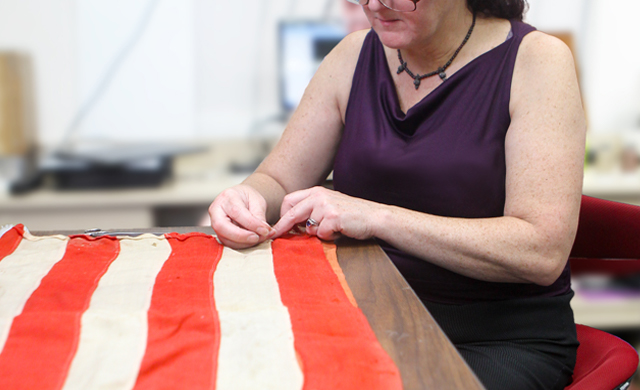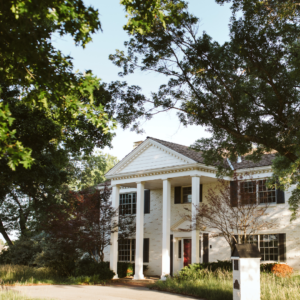Precious Fabric of History
Precious Fabric of History
Few people can claim to have touched Alexander Hamilton’s coat or the Star Spangled Banner. Anne Murray Chilton has done both. As a textile conservator, Anne specializes in helping museums and private individuals preserve the future of some of the world’s most precious fabrics. She’s worked on an impressive array of flags, quilts, uniforms, and teepees spanning across America’s history.
“My goal is to assess each piece and decide which treatment prevents further damage to the item,” Anne said. “In many cases, textiles are utilitarian, handmade objects that are not very well preserved because they were used every day.”
Preserving textiles is a highly-specialized career, and one that Anne describes as tedious but satisfying. “I spend a lot of time sewing with surgical needles, using thread that is finer than human hair,” Anne said. Her home studio has specialized lamps, magnifying glasses, and enough space for multiple tables.
“A textile can be quite large, so I have to pre-plan how to move it, flip it over, or reach the middle. When I was working on the Star Spangled Banner for the Smithsonian, we set timers to remind us to get up and stretch, because we contorted ourselves into such strange positions. There was a gantry bridge hanging about six inches above the flag. We laid on our stomachs, with our arms out in front of us while we attached the flag to a support fabric.”
Anne discovered textile conservation after achieving degrees in anthropology and art history. With no career prospects, she took a job restoring oriental carpets and Navajo blankets. “I found out that textile conservators existed, so then I went back to school for two years of organic chemistry in order to get into graduate training.”
During Anne’s college internship, she and another conservator spent over 500 hours conserving a confederate captain’s coat for the National Parks Service. “The coat was in shreds, but there aren’t many left, so it was an object worth preserving.” She also worked on a fragile silk and wool two-sided flag from Fort Pulaski. “The flag was very damaged and stored in a heavy storage frame. Since the flag is evacuated during hurricanes, it needed both repair work and a lighter-weight frame.”
Although Anne is the only textile conservator in Oklahoma, she works on artifacts from across the nation. Many are textiles that hold sentimental value to an individual family, such as quilts or war artifacts–but she’s also regularly hired by museums seeking expert care for their historic clothing collections. In recent years she’s worked on a wildlife art tapestry for the Oklahoma City Zoo and assessed the textile collections for both the Edmond Historical Society and Museum and the University of Central Oklahoma.
“Every artifact offers its own challenges, but the goal is to stabilize the item and document what was done. As much as possible, conservators choose treatments that can be reversed as new technologies emerge.” It’s the very reason why Anne found herself lying above the Star Spangled Banner, working to reverse 200 years of damage. “I’ve seen some amazing things during my career,” Anne said. “I find it greatly satisfying to fix and preserve textiles for future generations.”
To contact Anne about conservation work, place a request through the American Institute for Conservation.





